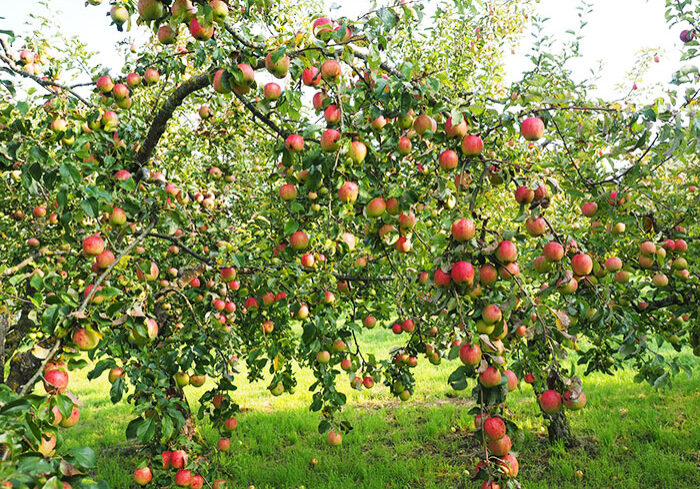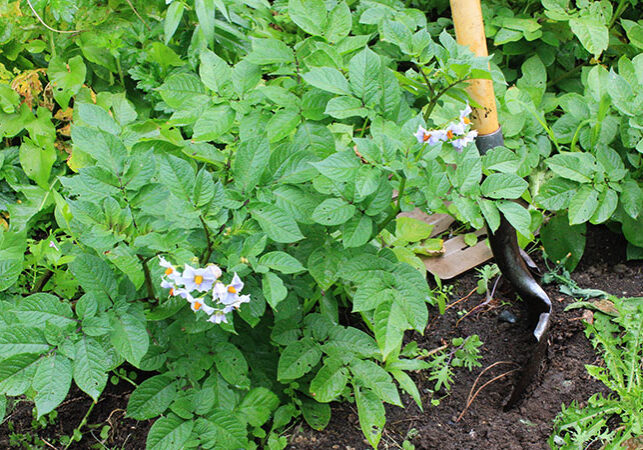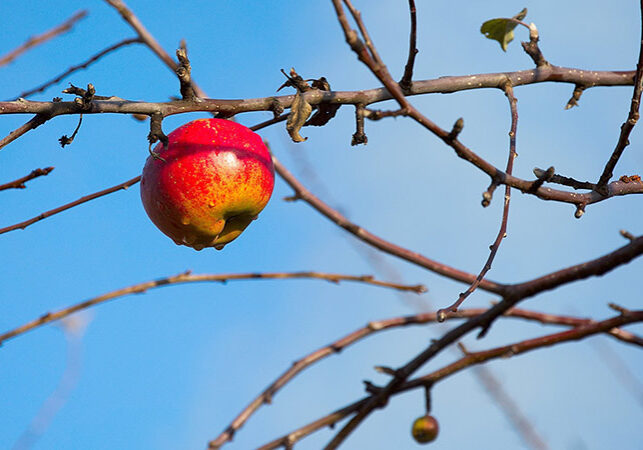FRUIT TREES & BERRIES
You can grow a TON of fruit in the Northwest, from fruit trees, to berries and beyond. Whether you're a seasoned orchard keeper or brand new, we're here to help.
Where to Begin?
EASIEST TO GROW
These are adapted to PNW climate, fairly pest and disease free, and require minimal training & pruning.
- Aronia
- Blackberry
- Blueberry
- Currant
- Elderberry
- Gooseberry
- Lingonberry
- Marionberry
- Raspberry
- Strawberry
MODERATELY EASY
These are adapted to PNW climate, fairly pest and disease free, but may need training and support.
- Crabapple
- Cherry, Pie
- Cherry, Cornelian
- Fig
- Hazelnut
- Kiwi, Hardy
- Persimmon
- Plum, European
- Plum, Asian
- Seaberry
CHALLENGING
These are well-adapted to PNW climate, but will need extra attention for pest and disease issues and require training and support.
- Apple
- Cherry
- Goji Berry
- Grape
- Kiwi, Fuzzy
- Pear, Asian
- Pear, European
- Quince
.MORE CHALLENGING
These fruits do not naturally thrive in the northwest, often needing a longer, hotter summer. They have more disease and pest issues and will need pruning and/or thinning.
- Apricot
- Citrus Fruit
- Nectarine
- Paw Paw
- Peach
What Fruit Needs to Thrive
Fruit trees, berry bushes, vines and canes all share some basic needs. Take a look at the information here to learn more, and don’t hesitate to speak to a Sky employee with questions.
All fruit needs a sunny location to be productive. Most require 6-8 hours of sunlight daily. Some need additional heat to ripen, and are more productive when planted against a south-facing wall. There are some berries and small fruits that will produce in shadier spots like blueberries, currant and elderberry.
Choose a planting area with well draining soil and fertilize according to recommendations for the specific variety. Usually, you’ll want to use a nitrogen rich fertilizer in early spring and a balanced fertilizer in the fall.
Regular pruning is important for many fruits, allowing sunlight to penetrate and air to circulate. This boosts photosynthesis, helps fruit ripen and helps minimize spread of fungal diseases. Pruning is also important to control plant growth.
Some tree fruit like apples and pears require 'thinning.' This means removing some of the fruit when around marble-sized to allow space and nutrition for the remaining fruit to grow, and prevent overburdening the branches.
Each type of fruit has their own specific sensitivities to pests and disease. Talk to Sky’s Tree and Shrub department for advice and individual care sheets on specific issues or check out this full-color comprehensive Pest Management Packet for PNW Fruit from WSU.
Some fruit trees are self-fertile, while others require a compatible variety blooming nearby at the same time. For best results trees need to be within approximately 100 feet of each other for pollination. Keep in mind, this can include a neighbor’s tree. You can also plant a combination tree, grafted with multiple, compatible varieties.
Fruit Trees
The majority of our fruit trees arrive every year sometime in February. If you're new to tree fruit, there are some important things to consider before you get started. Click the link below for considerations to get you started on the right foot.
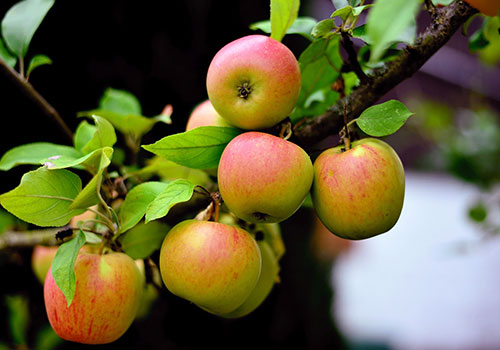
APPLES
Espalier, combination, & single varieties available.
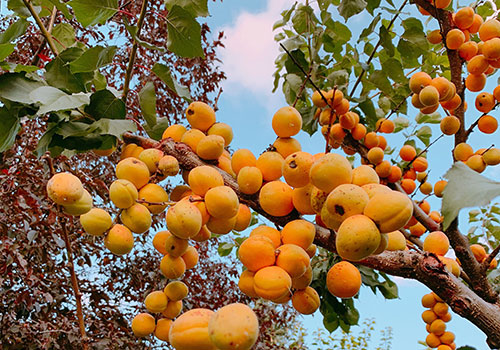
APRICOTS
A delicious challenge for northwest fruit growers.
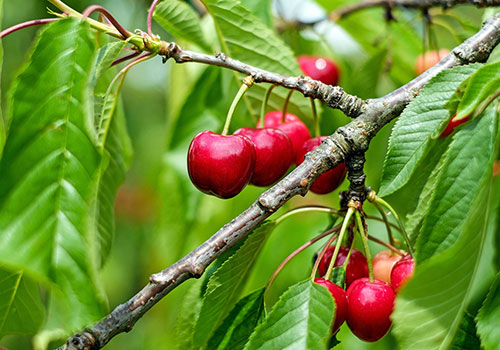
CHERRIES
Sweet & tart/pie varieties for harvest in mid-summer.
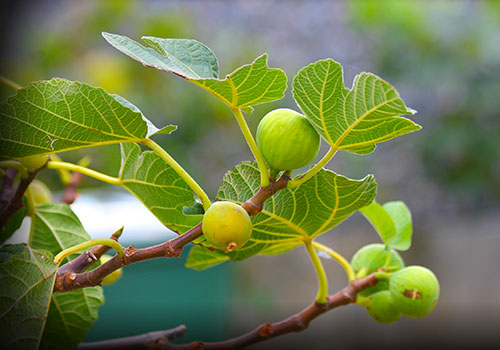
FIGS
European & Asian Figs arrive later in the season than other fruit trees.
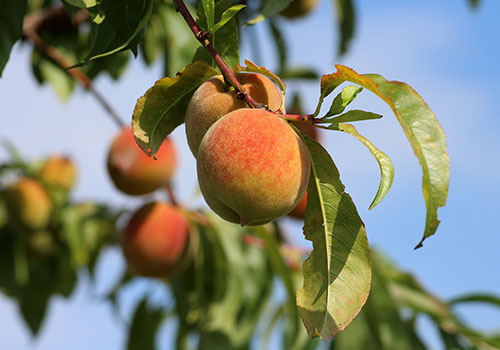
PEACHES & NECTARINES
Limited selection of Northwest-bred varieties available.
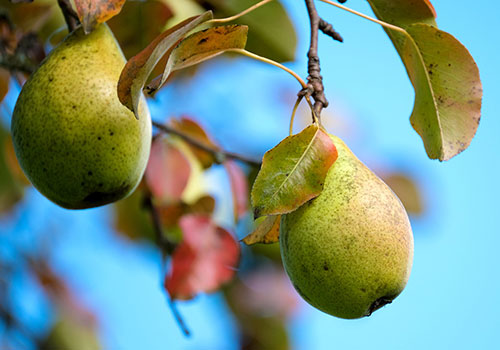
PEARS
Asian & European varieties for late summer-fall harvest.
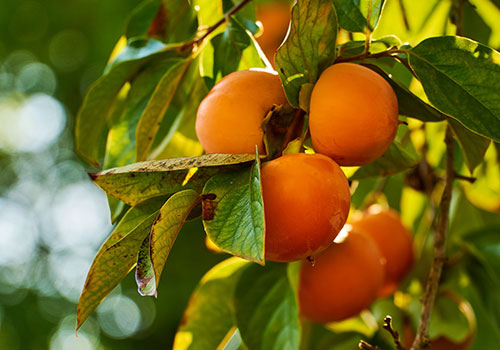
PERSIMMON
Asian & American Persimmons and beyond.
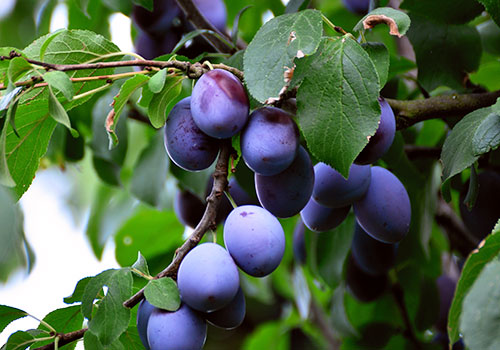
PLUMS
Asian & European varieties available.

Keep in mind, our selection is always changing. Many varieties of fruit arrive in one big shipment sometime in February. Please give us a call to check availability.
Berries, Small Fruits & More
Most small fruits are closely related to many northwest native edibles, which means that they often thrive in our climate, making them a great place for beginners to start growing their own fruit. The first selection arrives early February, with more coming in late month, and into spring.
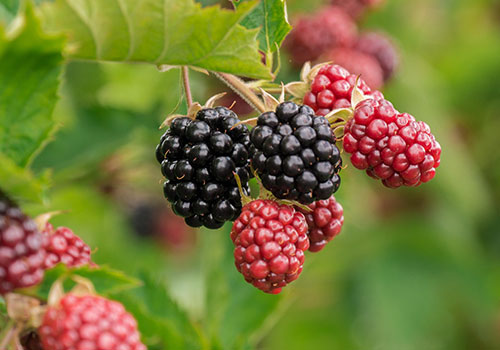
BLACKBERRIES
Thorny, thornless & patio blackberries - available most of the year.
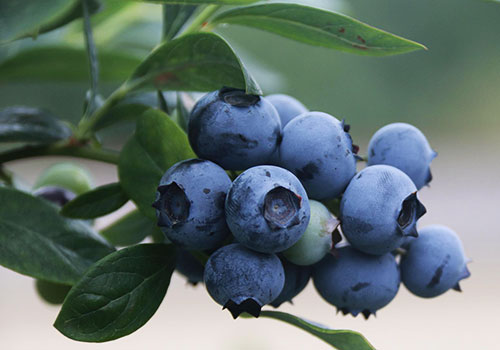
BLUEBERRIES
Northern, southern & patio blueberries for every space, available most of the year.
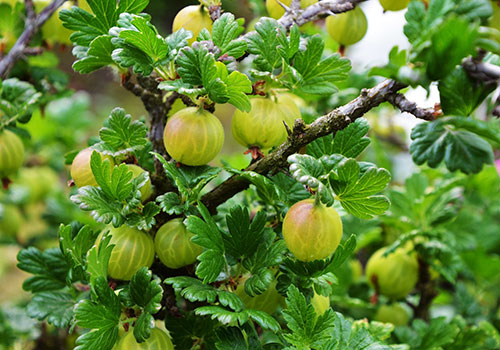
GOOSEBERRIES & CURRANTS
Easy growing & delicious, available almost year-round
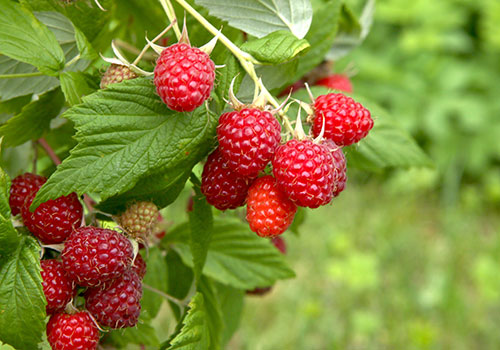
RASPBERRIES
Summer-crop, everbearing, and patio raspberries available most of the year.
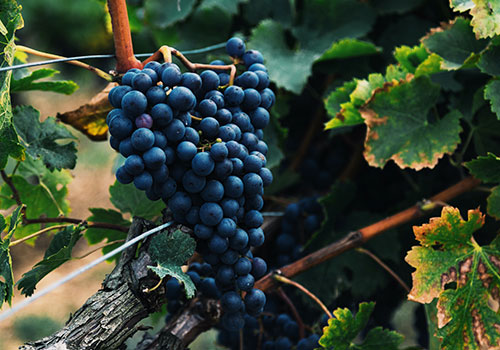
EDIBLE VINES
Hardy & fuzzy kiwi, grapes and hop vines are available at Sky late-winter to spring.
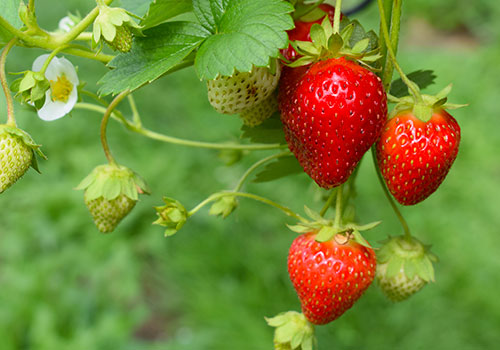
STRAWBERRIES
We expect day-neutral, everbearing & alpine strawberries March - June.
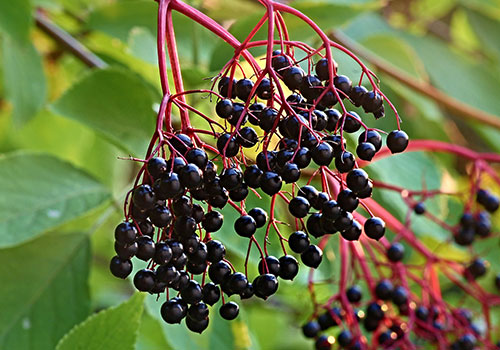
UNIQUE EDIBLES
Elderberry, Seaberry, Goji, Szechuan Pepper, Pineapple Guava available on occasion.
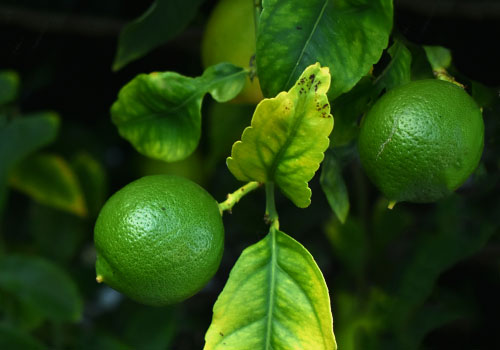
CITRUS FRUIT
Lemons, limes, orange, kumquat & more available year-round. NOT HARDY in PNW, for indoors only.
Frequently Asked Questions
Sky Nursery is here to help you succeed as you set out on the deeply rewarding journey of growing your own fruit.
Afraid you'll change your mind once you get home? We can accept returns (with receipt) for trees & shrubs up to 30 days after purchase. Plants must be unplanted, and in original container.
Feeling a little nervous about the big investment? We're proud to offer a guarantee on all Trees & Shrubs against against defects, disease and mislabeling for up to 1 year after date of purchase.
Berries related to Northwest natives tend to be the very easiest to grow here: aronia, blackberry, blueberry, currant, elderberry, gooseberry, raspberry, and strawberry. The easiest tree fruits are crabapples, pie cherries, plums and (full sun locations only) figs and persimmons. Other trees such as apples and sweet cherries require more care, but all varieties carried by Sky produce in the Seattle area.
Most fruit trees consist of a fruit-producing top (called scion) grafted onto a rootstock that imparts desirable characteristics to the tree as a whole: typically dwarfing the tree (a full size apple or cherry tree might reach 30-35' tall and wide), often imparting earlier fruit production or hardiness or disease resistance. See our blogpost on rootstocks for more information.
Choose a high-quality organic, granulated fertilizer when you plant, and once a year thereafter. Fertilizers labeled “All-Purpose” or “Fruit Tree/Berry” will both work well. If your soil is heavy, amend with a coarse compost; if very sandy, with a fine-textured one. Mulch well with coarse compost after planting, and try to keep both weeds and lawn well away from the tree trunk.
You may have heard that blueberries need acidic soil, but use caution before trying to change your soil pH. Most Pacific Northwest gardeners have naturally acidic soil that is just about perfect for blueberries as it is. We typically have to battle this natural acidity when we’re growing plants that prefer a neutral pH, such as most vegetables, by adding lime every year. But we can take a break and enjoy the perfect natural match when we grow acid-lovers like blueberries.
You can plant fruit trees anytime the ground isn’t frozen, but late winter or early spring is an ideal and traditional time. If you plant them while they’re still dormant, they’ll have a chance to settle in before growing their spring leaves. We receive most of our fruit trees for the year in late January, so you’ll find our best selection in February.
Many berry plants will make plenty of leaves in part-shade, but unfortunately there’s just no substitute for full sun if you want to harvest lots of ripe, well-developed fruits or berries. Producing fruit takes a lot of energy, and plants are solar-powered. Give your fruit trees and berry plants as much sun as you possibly can. If sun is just not an option, there are still other edible plants you can grow in part shade.
Many fruit and berry varieties require cross-pollination from a different variety of the same fruit. Sky's fruit tree and berry lists will tell you if a plant is self-fertile or needs a pollinizer. If it does need cross-pollination, you can always cross your fingers and hope a neighbor has an appropriate mate, but it’s best to grow multiple varieties yourself. If you have limited space, combination fruit trees are a great option. They have multiple varieties grafted onto the same root-stock, so you have all the cross pollination you need in one tree. Even if a plant is self-fertile, like some blueberries, it may still produce more fruit if you plant another variety nearby.
On the Blog
What’s a Rootstock? Grafted Fruit Tree Basics
Most of the fruit trees we sell at Sky are grafted, meaning that they are actually a combination of at least two trees! This goes not only for our “combination”…
Read MoreFeed Your Soil, Feed Your Plants: build a soil ecosystem
A garden is a living ecosystem that starts with the soil. Each handful of healthy soil contains billions of microscopic fungi, bacteria, and animals that are hard at work transforming organic…
Read MoreDormant Sprays for Fruit Trees: prevent pest problems now
For healthy fruit trees this summer, here’s what to do right now.
Read MoreFruit Trees - Searchable List
Fruit Trees are in! Check out our list of varieties for Spring 2025 below.
This is the bulk of our main order of trees, but we do see additional fruits on deliveries through out the year. As always, you can call to confirm what's available, as stock can change quite quickly! List Updated 01/31/25
| Combination Apple 1 (4-5 Varieties) | Chehalis (yellow), Cosmic Crisp® WA 38 cv (red), Gravenstein (yellow/red), Honeycrisp (red), Sunrise Magic® WA 2 cv (red) | Varied | Semi-Dwarf MM106 | Self fertile; each branch is a different variety, check branch color tags | |
| Combination Apple 2 (4-5 Varieties) | Akane (red), Chehalis (yellow), Honeycrisp (red), Liberty (red), Spartan (red) | Varied | Semi-Dwarf MM106 | Self fertile; each branch is a different variety, check branch color tags | |
| Combination Cherry (4-5 Varieties) | Bing (black), Glacier (red), Montmorency (pie), Rainier (yellow), Stella (red), Sweetheart (red), Van (red) | Varied | Dwarf Gisela 5 | Self fertile; each branch is a different variety, check branch color tags | |
| Combination Asian Pear (4-5 Varieties) | Chojuro (brown), Kosui (bronze), Nijiseiki (yellow), Shinko (brown-green), Shinseiki (yellow) | Varied | Semi-Dwarf OHxF87 | Self fertile; each branch is a different variety, check branch color tags | |
| Combination European Pear (4-5 Varieties) | Bartlett (yellow), Bosc (green russeted), Flemish Beauty (yellow blushed pink), Red Bartlett (red), Rescue (red/yellow) | Varied | Semi-Dwarf OHxF87 | Self fertile; each branch is a different variety, check branch color tags | |
| Combination Plum (4-5 Varieties) | Brooks (purple), Italian Prune (purple), Seneca (red), Stanley (purple), Yellow Egg | Varied | Dwarf St. Julien A | Self fertile; each branch is a different variety, check branch color tags | |
| Combination Fruit Cocktail (4-5 Varieties) | Apricot Puget Gold, Cherry Lapins and/or Rainier, Nectarine Hardy Red, Peach Frost, Plum Italian Prune | Varied | Dwarf St. Julien A | Self fertile; each branch is a different variety, check branch color tags | |
| Combination Fruit Salad (4-5 Varieties) | Apricot Harcot and/or Puget Gold, Nectarine Hardy Red, Peach Frost, Plum Italian Prune and/or Shiro | Varied | Dwarf St. Julien A | Self fertile; each branch is a different variety, check branch color tags | |
| Espalier 3-Way Apple Combo 1 | Cosmic Crisp® WA 38 cv (red), Honeycrisp (red), Sunrise Magic® WA 2 cv (red) | Varied | Semi-Dwarf MM106 | Self fertile | |
| Espalier 3 Way Apple Combo 2 | Gala (red), Honeycrisp (red), Fuji (red) | Varied | Semi-Dwarf MM106 | Self fertile | |
| Espalier 3-Way Asian Pear Combo | Chojuro (brown), Nijiseiki (yellow), Shinseiki (yellow) | Varied | Semi-Dwarf OHxF87 | Self fertile | |
| Espalier 3-Way European Pear | Bartlett (yellow), Bosc (green russeted), Red Bartlett (red) | Varied | Semi-Dwarf OHxF87 | Self fertile | |
| Akane Apple | Medium sized red | Firm, crisp, flavorful eating and dessert type | Early to Mid September | Dwarf M26 | Superior to Red Delicious, scab and mildew resistant, WWFRF. Needs pollinizer |
| Ashmead's Kernel Apple | Medium, russeted green | Sweet-tart, aromatic | Mid October | Dwarf M26 | Connoisseur's favorite; good keeper, scab resistant, not a good pollinizer. WWFRF. Needs pollinizer |
| Cosmic Crisp® Apple | Large sized red with white flecks | Crisp, firm, juicy, sweet and tart combination | September | Dwarf M26, Mini M27 | WSU licensed and limited to grow only in WA, vigorous and productive, tasty fruit stores well; may need hot summers to ripen. Needs pollinizer |
| Early Pink Lady® Maslin cv Apple | Medium, yellow blushed pink | Very crisp, sweet-tart | September | Dwarf M26 | Early ripening version of the classic Pink Lady, ripens better in Western WA. Needs pollinizer |
| Fuji (Beni Shogun) Apple | Large, russeted light red | Crisp and sweet | Early October | Dwarf M26 | Early ripening version of the classic Fuji, ripens better in Western WA. Needs pollinizer |
| Gala Apple | Medium sized reddish orange | Crisp, juicy and aromatic | Early October | Dwarf M26, Mini M27 | Good fresh eating and good keeper. Needs pollinizer |
| Granny Smith Apple | Green | Firm, crisp and tart | Mid October | Dwarf M26 | Great tart apple for eating and cooking; may need hot summers to ripen well. Needs pollinizer |
| Gravenstein Apple | Medium sized yellow with red stripes | Firm, crisp, tart and juicy | Early September | Dwarf M26 | Great for cooking & eating, not a good pollinizer, WWFRF. Needs pollinizer |
| Honeycrisp Apple | Medium red | Crisp, tart and sweet | Mid September | Dwarf M26 | Scab resistant, good for cooking and eating, WWFRF. Needs pollinizer |
| Liberty Apple | Medium red | Firm, crisp and juicy | Early October | Dwarf M26 | Scab and mildew resistant, excellent all purpose apple, excellent pollinizer, WWFRF. Needs pollinizer |
| Spartan Apple | Medium dark red | Crisp, juicy, semi-tart | Mid October | Dwarf M26, Mini M27 | Excellent all purpose apple. Needs pollinizer |
| Sunrise Magic® WA 2 cv Apple | Medium, pink/red over yellow | Crisp, firm, juicy, sweet-tart | October | Dwarf M26 | WSU licensed and limited to grow only in WA, vigorous and productive; great keeper, gets sweeter in storage. Needs pollinizer |
| Zestar Apple | Large red | Tart, crisp, zesty with a hint of sweet | Early August | Dwarf M26 | Crispest of the early apples. Needs pollinizer |
| Golden Sentinel Columnar Apple | Large sized golden | Crisp, juicy, sweet | Early October | 7-12' Tall | Disease resistant and productive. Needs pollinizer |
| Scarlet Sentinel Columnar Apple | Large yellow-red | Crisp and sweet | Early October | 7-12' Tall | Disease resistant and productive. Needs pollinizer |
| Blushing Delight ™ Urban Columnar Apple | Yellow blushed red | Very sweet | Mid September | 8-10' Tall, 2' wide | Disease resistant and productive. Needs pollinizer |
| Golden Treat ™ Urban Columnar Apple | Golden | Sweet; harvest early for tarter fruit | Late September | 8-10' Tall, 2' wide | Disease resistant and productive. Needs pollinizer |
| Tasty Red ™ Urban Columnar Apple | Bright red | Sweet and juicy, similar to McIntosh | Late September | 8-10' Tall, 2' wide | Disease resistant and productive. Needs pollinizer |
| Dolgo Crabapple | Oval shaped red fruit | Tart and flavorful | Fall | Dwarf M26 | Upright spreading shape, great for making jelly, great pollinizer for early to mid blooming apples. Self fertile |
| Evereste Crabapple | Small red | Tart | Fall | 8-10' | Semi-weeping form, very ornamental, fruit good for jellies and pickling, excellent pollinizer for mid to late blooming apples. Self fertile |
| Harcot Apricot | Large orange-yellow with red blush | Juicy and sweet | Fall | Dwarf St. Julien A | Freestone, late bloomer with cold-hardy blooms, good for areas subject to late frosts, developed in Canada. Self fertile |
| Harglow Apricot | Medium bright orange | Firm and very sweet | Fall | Dwarf St. Julien A | Freestone. Self fertile |
| Wenatchee Moorpark Apricot | Medium golden | Rich flavorful | Fall | Dwarf St. Julien A | Produces better in dryer, warmer weather, good, fresh dried or canned. Self fertile |
| Bing Cherry | Large, dark mahogany red | Sweet, firm & juicy | Early July | Dwarf Gisela 5 | The standard for black cherries! Vigorous, heavy producer. Subject to cracking in rains. Needs pollinizer. WWFRF |
| Black Gold Cherry | Large, dark red | Sweet & juicy | Late July | Dwarf Gisela 5 | Excellent flavor. WWFRF. Self fertile |
| Carmine Jewel™ Pie Bush Cherry | Small, bright or dark red | Tart | July | 6-8' bush | Pick while bright red for pies and cooking, or let ripen to black for fresh eating. Self fertile |
| Evans Pie Cherry | Small, dark red | Tart and flavorful | July | 8' natural dwarf tree | Morello type cherry great for pies and canning. Self fertile |
| Glacier Cherry | Large dark red | Sweet & juicy | Mid July | Dwarf Gisela 5 | Developed for Western WA by WSU. Self fertile |
| Lapins Cherry | Large, black | Good | Late July | Dwarf Gisela 5 | Similar to Bing but softer. Crack resistant. WWFRF. Self fertile |
| Montmorency Pie Cherry | Small bright red | Sweet-tart and juicy | Early July | Dwarf Gisela 5 | Heirloom pie and canning cherry. WWFRF Self fertile |
| Morello Pie Cherry | Dark red | Tart and aromatic with dark juice | Late July | Dwarf Gisela 5 | Tart, dark, aromatic fruit, great for pies and canning. Productive tree. Self fertile |
| Rainier Cherry | Large yellow with pink blush | Sweet and firm | Early July | Dwarf Gisela 5 | Northwest classic yellow/red cherry. WWFRF. Needs pollinizer |
| Royal Ann Cherry | Large yellow with red blush | Sweet and juicy, spritely flavor | July | Dwarf Gisela 5 | Softer than Rainier; great cooked cherry. Needs pollinizer |
| Stella Cherry | Large dark red | Sweet, firm and juicy | Early July | Dwarf Gisela 5 | Resists cracking, good quality. WWFRF.Self fertile |
| Sweetheart Cherry | Large bright red | Sweet firm and juicy | Late July | Dwarf Gisela 5 | Good quality. WWFRF. Self fertile |
| Tehranivee Cherry | Large, mahogany red with black-red juice | Sweet, firm and juicy; very flavorful | Late July | Dwarf Gisela 5 | WWFRF. Self fertile |
| Vandalay Cherry | Large black | Delicious | Early July | Dwarf Gisela 5 | Resistant to cracking. WWFRF. Self fertile |
| Brown Turkey Fig | Mahogany skin, amber flesh; large | Sweet and rich | August-October | 10-25' | Best against south or west wall. Will sometimes bear two crops. HHR. Self fertile |
| Desert King Fig | Green skin, strawberry flesh | Sweet and delicious | Mid August | 10-25' | Very reliable, good in cooler locations, good fresh or dried, HHR. Self fertile |
| Hardy Chicago (aka Bensonhurst Purple) Fig | Purple skin, dark red flesh, small | Sweet rich flavor | Fall | 10-25' | Cold hardy once established; can freeze to ground, regrow, and produce crop in fall. Self fertile |
| Lattarula (aka Italian Honey) Fig | Green skin, honey flesh | Sweet and mild | Early fall | 10-25' | Good producer, superb for eating, canning or drying, HHR. Self fertile |
| Little Miss Figgy Fig | Burgundy to dark purple skin, amber flesh | Sweet rich flavor | Fall | 4-6' | Very dwarf, excellent in containers. Self fertile |
| Olympian Fig | Purple skin, red-purple flesh | Large sweet | Late July | 10-25' | Discovered in Olympia. Self fertile |
| Violette De Bordeaux (aka Negronne) Fig | Dark purple, almost black, dark red flesh | Sweet rich flavor | September | 6-10' | Good in containers and small spaces. Self fertile |
| Breda Medlar | 1" brown fruit | Cinnamon applesauce flavor | after frost | 10-15' | Pick fruit after first frost; let soften ("blet") on windowsill. Eat or make jam when very soft and fragrant.. Self fertile |
| Contorted Mulberry | Blackberry-like | Sweet rich flavor | Fall | 6-8' | Ornamental dwarf tree with contorted branches. Small crop of tasty fruit. Fruit can stain. Self fertile |
| Illinois Everbearing | 1 1/2" long, black when fully ripe | Sweet & juicy | June-July | 20-30' | Fruit looks like elongated blackberry, but is sweeter. Fruit can stain. Self fertile |
| Hardy Red Nectarine | Red skin with gold blush, yellow flesh | Excellent | Fall | Dwarf St. Julien A | Semi-freestone, self-fertile, WWFRF, prone to peach leaf curl |
| Eta Hazelnut or Filbert | Small | Good flavor | Fall | 10-20' | Used in commercial orchards to pollenize Jefferson. Small yields of tasty nuts. Needs pollinizer |
| Jefferson Hazelnut or Filbert | Medium sized, round | Excellent flavor | Fall | 10-20' | Best all-round variety for the Northwest. High yields, excellent flavor. Upright tree. Needs pollinizer |
| Polly O Hazelnut or Filbert | Medium sized, round | Excellent flavor and aroma; good in chocolates | Fall | 10-20' | High yielding, good quality; early to ripen Upright vigorous tree. Needs pollinizer |
| Theta Hazelnut or Filbert | Small | Good flavor | Fall | 10-20' | Best pollinizer for Jefferson. Small yields of tasty nuts. Needs pollinizer |
| Wepster Hazelnut or Filbert | Small | Flavorful, very high quality | Fall | 10-20' | High yielding, flavorful nuts. Upright vigorous tree. Needs pollinizer |
| Yamhill Hazelnut or Filbert | Small | Sweet flavor | Fall | 10-20' | High yields, good quality, smaller and earlier than Jefferson. Needs pollinizer. |
| Carpathian English Walnut | Brown | Mild good flavor | Fall | 40-60' | Common supermarket walnut, thin shells; large, handsome vigorous tree; partly self-fertile |
| Manregion English Walnut | Brown | Good flavor | Fall | 35-50' | Common supermarket walnut, thin shells; large, handsome vigorous tree; partly self-fertile |
| Arbequina Olive | Black-brown, small | Good flavor and aroma | Early | 10-20' | Spanish variety, graceful spreading/weeping habit, fruit good for oil or fresh eating, self fertile; may not ripen in cold summers |
| Frost Peach | Yellow-orange with yellow flesh | Sweet, juicy, good flavor | Mid August | Dwarf St. Julien A | Semi-freestone, good for canning or fresh eating, resistant to peach leaf curl, WWFRF. Self fertile |
| Chojuro Asian Pear | Medium size, light brown | Crisp, aromatic and firm | Mid September | Semi-Dwarf OHxF87 | Productive and good keeper, WWFRF. Needs pollinizer |
| Hosui Asian Pear | Very large, golden with russeting | Crisp, juicy, and very sweet | Early September | Semi-Dwarf OHxF87 | Needs pollinizer |
| Kosui Asian Pear | Medium size, russetted bronze | Crisp, sweet, aromatic, tender skin | Late August | Semi-Dwarf OHxF87 | Needs pollinizer |
| Nijiseiki (aka 20th Century) Asian Pear | Medium size, yellow-green | Firm and juicy, mild; most popular variety | Mid September | Semi-Dwarf OHxF87 | Needs pollinizer |
| Shinseiki Asian Pear | Medium to large, yellow | Crisp, juicy, and aromatic | Late August | Semi-Dwarf OHxF87 | Stores well. WWFRF. Needs pollinizer |
| Bartlett Pear | Large, yellow | Sweet and tender | Mid September | Dwarf Provence Quince | Good fresh or canned.WWFRF. Needs pollinizer |
| Bosc Pear | Long, narrow, russetted dark green | Firm, sweet, juicy and flavorful | Early October | Semi-Dwarf OHxF87 | Good fresh or canned.WWFRF. Needs pollinizer |
| Ubileen Pear | Very large, green blushed red | Award-winning flavor, sweet and buttry | Mid August | Dwarf Provence Quince | Very early, vigorous & disease resistant. Needs pollinizer |
| Early Fuyu Asian Persimmon | 2 1/2 - 3 " round, flattened; orange | Can be eaten firm for melon-like flavor, or let soften for sweet custardy flavor | November | 10-20' | Non-astringent type, earlier-ripening than Fuyu; can be maintained at 10-12'. Self fertile |
| Fuyu Asian Persimmon | 2 1/2 - 3 " round, flattened; orange | Can be eaten firm for melon-like flavor, or let soften for sweet custardy flavor | November | 10-20' | Non-astringent type; most popular variety. Self fertile |
| Hachiya Persimmon | 4" long acorn-shaped; orange | Sweet rich flavor when fully soft | November | 15' | Astringent type; finish ripening after picking. Popular, often found in supermarkets. Self fertile |
| Phoenix Asian Persimmon | 2 1/2 - 3 " round, flattened; orange | Sweet and flavorful when fully ripe | November | 10-20' | Astringent type; finish ripening after picking. Self fertile |
| Robin Asian Persimmon | 2 1/2 - 3 " round, flattened; orange | Sweet and flavorful when fully ripe | November | 10-20' | Astringent type; finish ripening after picking. Self fertile |
| Hollywood Asian Plum | Large, dark red skin, deep red flesh | Sweet and firm | Late August | Dwarf St Julien A | Very ornamental tree with pink flowers and purple foliage, WWFRF. Needs pollinizer |
| Methley Asian Plum | Medium size, purple skin, red flesh | Very sweet | July | Dwarf St Julien A | Very early, productive. WWFRF. Needs pollinizer |
| Satsuma Asian Plum | Medium size, deep red skin and flesh | Juicy, sweet, flavorful | Mid August | Dwarf St Julien A | Productive and vigorous tree. Needs pollinizer |
| Shiro Asian Plum | Large, yellow skin and flesh | Mild, sweet, very juicy | Early August | Dwarf St Julien A | Good fresh or cooked. WWFRF. Needs pollinizer |
| Blue Damson European Plum | Small, blue-black, yellow flesh | Tart, juicy, with a distinctive flavor | Early September | Dwarf St Julien A | Classic variety for jam, preserves, and chutney. Self fertile |
| Brooks European Plum | Large, dark purple skin, yellow flesh | Prune type; sweet, juicy, good flavor; freestone | Early September | Dwarf St Julien A | Excellent dried, cooked, canned, or fresh; commercial prune variety in Oregon. Self fertile |
| Green Gage European Plum | Medium size, green-yellow skin, amber flesh | Excellent sweet rich flavor; freestone | Late August | Dwarf St Julien A | Classic dessert plum; excellent fresh, baked, and in preserves. Self fertile |
| Imperial Epineuse European Plum | Medium size, purple skin, yellow flesh | Prune type; firm, sweet and flavorful; freestone | Mid August | Dwarf St Julien A | Excellent fresh and dried; French dessert/prune plum. . Needs pollinizer |
| Italian Prune European Plum | Medium size, dark purple skin, yellow flesh | Prune type; sweet, juicy, good flavor; freestone | Early September | Dwarf St Julien A | Seattle's favorite plum. Very productive; great fresh or dried. Self fertile |
| Seneca European Plum | Very large, red/purple skin, yellow flesh | Very sweet and juicy; freestone | Early September | Dwarf St Julien A | Excellent fresh and dried. . Needs pollinizer |
| Stanley European Plum | Large, dark purple skin, yellow flesh | Prune type; juicy, sweet and flavorful; freestone | Late August | Dwarf St Julien A | Very similar to Italian Prune. Self fertile |
| Yellow Egg European Plum | Large, yellow skin and flesh | Soft, sweet, and juicy | Early August | Dwarf St Julien A | Excellent for baking or canning. Self fertile |
| Pineapple Quince | Medium size, yellow | Very firm, pineapple aroma | October | 10' tree | Very ornamental small tree. High-pectin fruit great for jelly, cider, cooking. Self fertile |
| Smyrna Quince | Large, lemon yellow | Very firm, with complex floral/fruity fragrance | October | 10' tree | Very ornamental small tree. High-pectin fruit great for jelly, cider, cooking. Self fertile |

